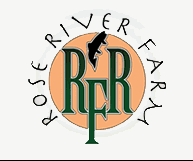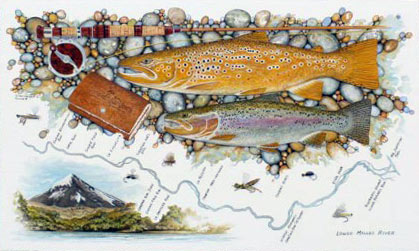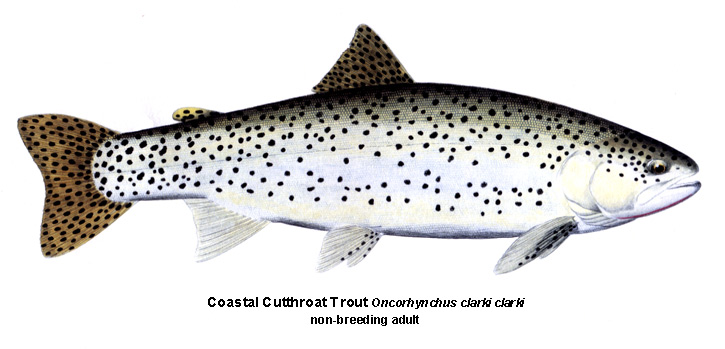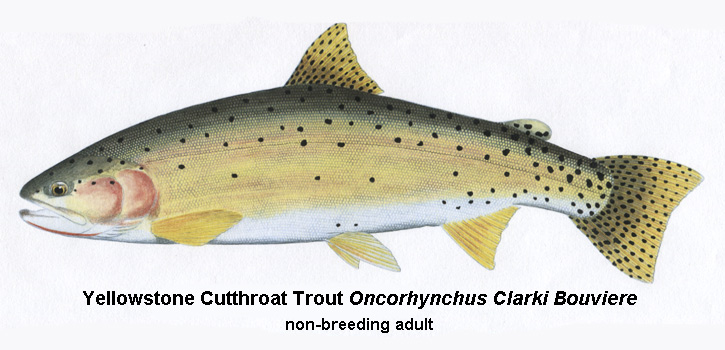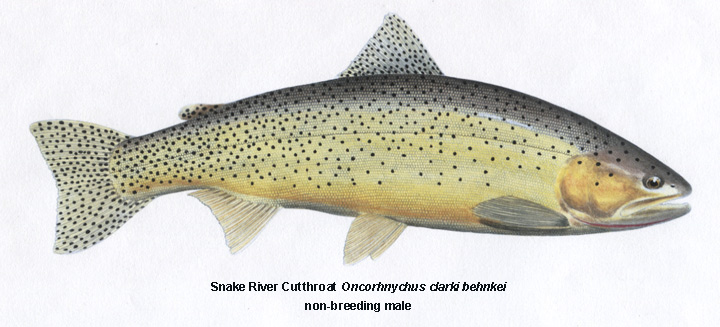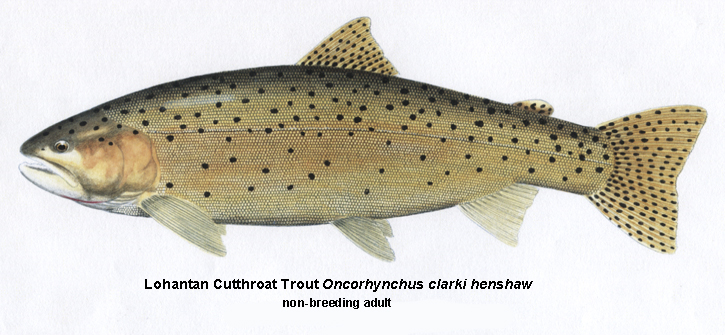Cutthroat Trout, July 2011, Fish of the Month!
Cutthroat Trout
Coastal Cutthroat trout: Oncorhynchus clarki clarki
Snake River Cutthroat trout: Oncorhynchus clarki behnkei
Yellowstone Cutthroat trout: Oncorhynchus clarki bouvieri
Lahontan Cutthroat trout: Oncorhynchus clarki henshaw
Westslope Cutthroat trout: Oncorhynchus clarki lewisi
Local Names:
Blue-back trout, Cutthroat, Red-throated trout, Clarks' trout,
Short-tailed trout, Native trout, Lake trout, Mountain trout
Average Size:
The size of Cutthroat trout is in direct proportion to the size of the habitats in which they live. Small upland streams will normally produce adult Cutthroats in the 8 to 12 inch range. Where they are found in large lakes, Cutthroats can grow to an impressive size of 20 to 30 inches and 5 to 10 pounds.
Distinguishing Field Marks:
The accompanying illustrations indicate the overall typical trout form of the various Cutthroat sub-species.
The red, yellow, or orange slash of color under the gills of all the Cutthroat subspecies distinguishes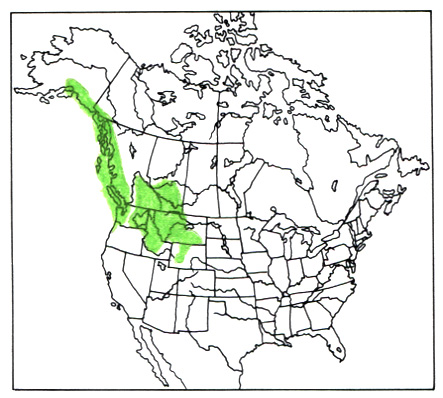 them from all other salmonids.
them from all other salmonids.
North American Range:
Map to the right shows approximate range in North America.
Diet:
Typical of trout, young Cutthroats feed on planktonic organisms that come their way on the natal stream's flow. As they grow larger, they begin to change their diets to ones made up mainly of immature and adult aquatic insects. In ponds and lakes, adult Cutthroats continue feeding on aquatic and terrestrial insects, other invertebrates as available and small fish. In salt water, Coastal Cutthroats feed mainly on fishes and shrimps.
Fly Fishing for Cuthroat Trout:
The various sub-species of this trout are real North American native trout. Unlike our other heritage “native,” the Brook trout, the Cutthroat is a true trout. In most of its range, it is a fish of the “wild places,” fragile habitats that often require serious effort to reach. That’s a good thing too because several other Cutthroat sub-species have already been brought to or are on the verge of extinction. It always strikes this author as a sad fact that we humans seem genetically programmed to decimate those species with which we share this planet that we most highly prize. I think we can truly say that “we’re our own worst enemies.” Next month this column will feature a trout that is a large part of the reason for on-going Cutthroat declines
Those Cutthroats that are maintaining healthy fishable populations continue to delight anglers with their willingness to accept our offerings. Of course, Cutthroats will take a baited hook, all trout (perhaps all fish) will. But the real pleasure in fishing for these elegant fish in their beautiful homes comes to the fly-fisher who takes the time to observe the fish in whatever type of habitat in which he finds them and offer them a carefully tied, carefully presented imitation of the Cutthroats’ natural food.
I know that, in many, if not most of our readers’ cases, I’m “preaching to the choir.” Those of us who have fished the long rod for many years can read range, habitat, and diet entries and know what equipment and flies to carry on an outing. But, for our new-comers to the gentle art, first of all, welcome. Then, when you choose to fish in high or moderate altitude small streams or lakes, assume that you’ll be mostly casting to small fish, so 2 to 4 weight outfits are in order. For the smallest steams, which offer angling pleasures all their own, rods between 7 and 7 1/2 feet are needed to keep your flies out of the stream-side vegetation as much as possible. On medium size streams, an 8 or 8 ½ foot 4 or 5 weight rig is perfect. On the larger trout streams/rivers you’ll want to choose outfits with rods between 9 and 10 feet in length, in the 4 to (even) 7 weight class. Lahontan Cutthroats are known to be on the large end of the Cutthroat length and weight scales. To fish large wets, dries, or streamers for these larger fish (Sea-run Coastal Cutthroats grow big and strong while feeding in the salt-chuck too), choose a 9 to 10 foot rod (this author is very partial to 10 to 11 foot rods) that can comfortably throw a 6, 7, or 8 weight line……Flies? Well the menu is HUGE. Immature and adult aquatic insect, mostly caddis flies, mayflies, and stone flies, imitations are in order for small to medium streams. Larger streams, ponds, and lakes will open the door for streamers and large wets and attractor dries. Enumerating all the fly possibilities available for Cutthroat trout fishing would fill a small book; small, but too big for this column…Oh yes, an important detail; match your leader’s tippet size (diameter) to the size flies you’ll be throwing. Your leader’s length will depend on fishing conditions. For instance, in windy conditions a long fine leader will be challenging to accurately cast. Conversely, a stiff large diameter tippet, appropriate for Steelhead and Atlantic salmon fishing is almost guaranteed to spook small fish in small waters. Freshmen, a word; keep at it, get as much dry land practice-casting and on the water fishing time as you possibly can. Practice two or three important knots enough so that you approach being able to tie them blindfolded. Most of all? Have fun. I have little patience for those of us who get so teched-out in this form of the angling arts that their seriousness makes them a real drag to fish with……HAVE FUN!!!!!!
O.K., once again, while you’re having all that fun? Be serious enough to deeply respect what a privilege it is to be able to access and fish literally millions of acres of the world’s best fly-fishable waters. That’s a place to begin; carry that respect to the fish you pursue AND the habitats in which you find them. Be a steward, not a conspicuous consumer of North America’s (and the rest of the world’s for that matter) remaining fish and wildlife stocks. A fish that I release today, I can fish to again tomorrow.
May Happy Trails lead you to Bright Waters…..


